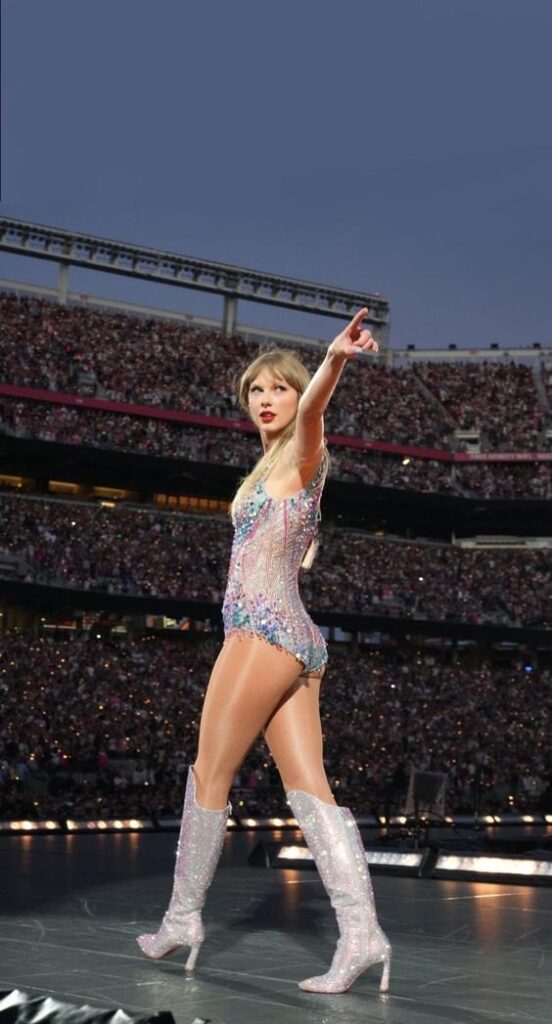You all should move over the Richter scale because earthquakes are old news when Taylor Swift hits the stage! Last year, Swifties brought their seismic energy to one of her epic L.A. concerts, literally making the ground shake.
Caltech and UCLA conducted a study to monitor how much the ground shook during one of Taylor’s concerts in 2023. One of her six L.A. shows at SoFi stadium proved that fans were not just rocking the house; they were rocking the entire planet! Now, that’s what you call Swiftie power!
The Earth Vibes to Swift’s Beat
Seismologist Gabrielle Tepp spills the tea on Taylor Swift’s seismic impact. At her “Eras” concert on August 5, 2023, with over 70,000 fans rocking out, the ground beneath SoFi stadium shook with seismic energy.

Tepp’s team tracked every song from within 5.6 miles, and guess which track caused the biggest tremor? You guessed it—Taylor Swift’s “Shake It Off” performance hit a seismic peak of 0.851 magnitudes.
ALSO READ: Nicki Minaj Reschedules “Pink Friday 2” Tour New Orleans Show
Tepp’s sensors caught every jump and dance move, but guess what? The music’s reverberations weren’t even factored in! “Love Story” struck a chord, too, leaving its mark on the meter. The L.A. show caused tremors equivalent to a magnitude-2 earthquake—impressive, right?
But there’s even more. Seattle’s Swifties caused similar waves last summer. Earthquake levels? You bet. When moving mountains, Taylor’s fans know how to rock the world. Overall, the results from these concerts are similar to those from the Swift concerts and support the audience-source hypothesis.
The research article says. “The (local magnitude) of the songs was in the same range as the Swift concerts, although none matched or exceeded the strongest Swift signal.” The researchers also analyzed three other concerts at SoFi in the summer of 2023: Morgan Wallen, Metallica, and Beyoncé.
More Details About Taylor Swift’s “Eras” Tour
According to Pollstar, Swift’s “Eras” Tour is the first tour ever to rake in over $1 billion—and that’s just the beginning. While Swift takes a brief break from shows, her tour gears up for its next chapter, kicking off on May 9 in Paris.
And mark your calendars because her eleventh studio album, “The Tortured Poets Department,” drops on April 19, promising even more musical magic from the pop queen herself.
ALSO READ: Beyoncé Sets the Record Straight on “Cowboy Carter” Album, Reveals Inspiration Behind It
More Volcano Than Earthquake
Gabrielle Tepp, the seismic genius behind the study, compared the Swiftie-induced tremors to a volcanic eruption rather than a typical earthquake. As a co-author and staff seismologist at Caltech Seismic Lab, she knows her stuff.
Explaining the findings, she likened earthquake signals to sharp jolts and found them easy to identify, but the Swiftie phenomenon? It’s a different vibe—more like the diverse signals of a volcano. With spectrograms as their trusty guide, Tepp and her team decoded the seismic symphony induced by Taylor’s fans.
The Swiftie Symphony
Even with a knack for strumming the guitar, Gabrielle Tepp’s seismic expertise revealed a different kind of harmony at Taylor Swift’s concerts. Initially attributing the harmonic signals to the music or instruments, Tepp and her team made a surprising discovery—it was the crowd itself causing the tremors.

Honestly, just forget the stage when Swifties unite. They become the show’s true stars, rocking the earth with their collective energy.
More Experiments from Tepp and Co
Gabrielle Tepp and her team experimented more on the Swiftie-induced tremors. They played Taylor Swift’s “Love Story” near the motion sensor and, to their surprise, discovered that jumping to the beat caused the sensor to go wild.
But that wasn’t all. Tepp’s bass guitar experiment also added another layer of intrigue. Here, she plugged her bass guitar into the speaker and played a repetitive beat. Despite her rhythmic bass beats, the jumping motion due to a concert crowd’s energy sent the sensor into a frenzy. Tepp’s conclusion?
She said, “Even though I was not great at staying in the same place – I ended up jumping around in a small circle, like at a concert. I was surprised at how clear the signal came out.” She added, “Metal fans often headbang, so they’re not necessarily bouncing. It might just be that how they move doesn’t create as strong of a signal.”
You Might Also Like:
8 Tips for Maintaining a Healthy Lifestyle
Elevating Denim with Bum-Enhancing Designs
Eiza González Recounts Troubling Experience After Losing Out on Roles for Being “Too Hot”
Study Says “Woke” People Are Less Happy and More Anxious
Former President Donald Trump’s Truth Social Stock Skyrockets On It’s First Day of Trading
